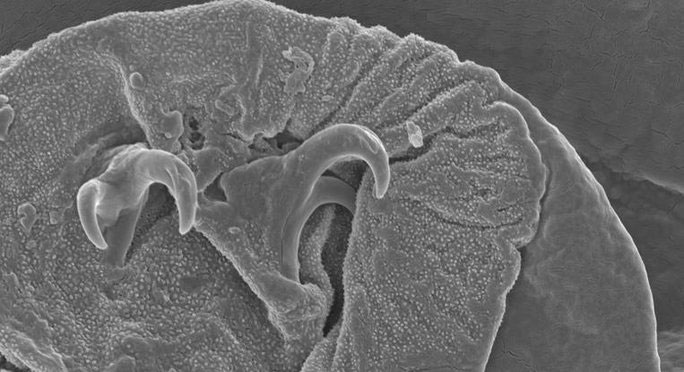Shocked with 'monster' resurrected after being eaten, calmly mating, giving birth
Two newly published scientific studies continue to shock the scientific community about the incredible diversity and immortality of Tardigrades, the monsters believed to be invading the Moon.
According to Science Alert, in the first study, Finnish scientists discovered a completely new species of Tardigrades living on lichens and mosses in the middle of Rokua National Park, which is famous for its beautiful sand dune landscape shaped by glaciers and wind.
The team of scientists, led by biologist Matteo Vecchi from the University of Jyvaskyla, initially set out to collect samples of moss, lichen, grass roots and fallen leaves from the dunes. But in this extremely inhospitable environment, they not only discovered Tardigrades crawling around, but also a new species.

Close-up portrait of new species - (Photo: Zoological Studies).
To adapt to the sand dunes, the Tardigrades here have evolved into a species with smaller limbs to easily crawl across the unique terrain.
The new species' " face" reminded scientists of the character Nagini in the novel "Harry Potter" , a woman cursed and turned into a limbless beast, so they named it Macrobiotus naginae .
The sand dunes here are usually deadly to all animals because they go through periods of almost no water, but Tardigrades once again demonstrate their ability to desiccate and then revive when water is available, so they are still alive and well .
In a second, completely independent study, Dr. Matteo Vecchi found another way that Tardigrades can survive besides desiccating themselves and coming back to life: By being eaten by snails.
Snails are much larger than Tardigrades, so they can easily eat them. Tardigrades also "hitchhike " to snails when they need to travel long distances, because the difference in size also helps snails crawl much faster than them.
So what if they are unlucky enough to be eaten? Researchers tried reviving 10 tardigrades from wild snail droppings in a Finnish garden and were stunned when five of them survived.
In another experiment, they fed 694 tardigrades to snails and recovered 218 live ones in their feces. Another 78 were present in the feces but were dead, and another 398 were presumed to have been digested in the snails' stomachs.
However, the 31% of the "troops" that survived after being eaten were surprising enough . But these survivors remained healthy as usual, calmly reproducing successfully when kept and monitored in the laboratory.
Two studies recently published in Zoological Studies and Ecology provide more interesting data for the immortal monsters that scientists around the world are hoping for: Turning them into astronauts on spaceships, even ambitiously interbreeding with humans to provide astronauts with some genes that help them withstand cosmic radiation.
These tiny monsters have been found in the world's most extreme environments, surviving many a chilling test. Some are believed to be invading the Moon after falling from a crashed Israeli spacecraft a few years ago.
- Two births were separated right ... 9 months
- Panda giving birth at the American zoo
- China is close to the goal of giving birth to a baby in the universe
- Animals humans have never seen the process of giving birth
- How are Western women born
- Python gives birth to babies without mating
- Why has Japan's birthrate been at a record low in 120 years?
- Women give birth for the first time, can they give birth twice?
- The sea monster that is mating is permanently attached
- Can revive the dead?
- Video: Visitors 'give birth to' sharks
- Blood tests can predict pregnant women giving birth prematurely
 Animal 'suffering' after hibernation
Animal 'suffering' after hibernation Why do goats climb well?
Why do goats climb well? Scientists were surprised to see chimpanzees eating turtles
Scientists were surprised to see chimpanzees eating turtles Giant catfish died deadly due to drought in Thailand
Giant catfish died deadly due to drought in Thailand